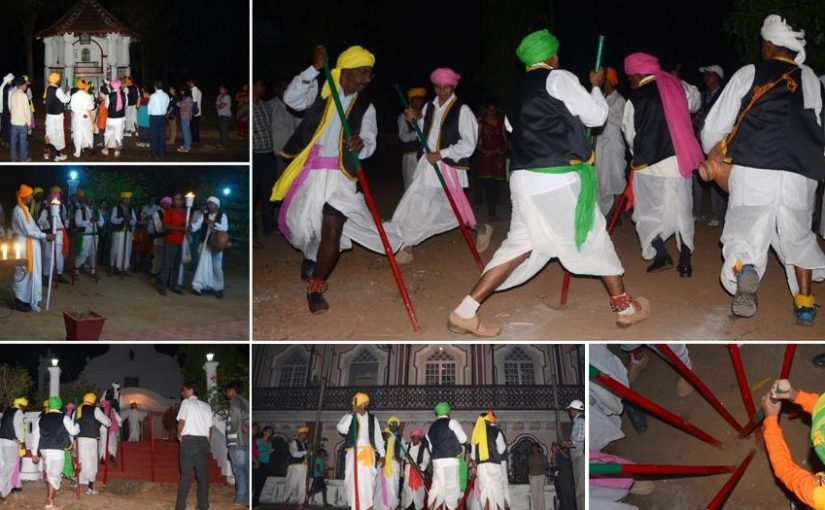FOR Catholics in Goa, March ushers in the season of Lent when Jesus Christ fasted for 40 days and nights in the desert. This is the season when Catholics undergo a fast by forsaking meat and relinquishing some luxury or indulgence they are addicted to. One day before Ash Wednesday, the Mussol Khel is held in Chandor every year without fail. This is a traditional dance which dates back to antiquity. Not just centuries as some writers would have us believe.
A mussol is basically a “pestle” and hence the dance translates to a pestle dance. It is a lilting pounding pestle dance where the dancers rotate clockwise and also anti-clockwise while moving in a circular manner and singing rhythmically. The rhythm of the song matches with the dance steps evoking a sense of nostalgia.
The participants gather at the St Anthony’s chapel or copel at Cavorim in Chandor before moving on foot to old houses and mansions in the village. Chandor is divided into three wards known as Cotta, Cavorim and Guirdolim. Each ward has a separate Mussol troupe which begin to gather around 7.30 pm at the chapel before moving to the houses of their respective wards.
What makes this dance fascinating is that the troupe comprises mostly of Chardos or Kshatriyas who were the earliest gaonkars or settlers of the village. Hence, the troupe visits the mansions or houses of these Chardos who have descended from their forefathers. There has been inter-marrying and whether the pure Chardo strain has been preserved is an arguable point. But the fact remains that the Mussol Khel organizers have maintained an ancient tradition and know who are the Chardos of yore and who are their descendants.
CHANDOR OLDEST
CHANDOR is arguably the oldest village in the state of Goa with remnants of ancient settlements and an old bull seen at Cotta. The Archaeological Survey of India did some excavations in Cotta but tragically, the report is not available or accessible because the person who wrote the report passed away.
The troupes visit only the houses of the Chardos which critics flay as upholding the caste system. This is false because there is a provision in the Constitution which protects minority culture and tradition and when the gaonkars of yore settled in Chandor, they did so based on the caste to which they belonged. Over 600 years back, and even into the 1500s and 1600s, when the Portuguese ruled Goa, the caste system was prevalent among the Hindu community so that Chardos who were the earliest gaonkars of this village, did not intermingle or intermarry among the lowest castes who were called “Sudirs.” They were the artisans who were the cobblers, carpenters or domestic servants.
Another interesting aspect of the Mussol Khel is that only males take part in this pestle dance with their wives or daughters clapping or singing in unison. The reason for this is because in ancient times, the males took the decisions concerning property and income. Women looked after the household and did not harvest the paddy which the menfolk traditionally dominated.
ANCIENT TRADITION
IT IS praiseworthy that the Mussol Khel dancers can identify the descendants of their forebears in the distant past to maintain a continuity in this ancient tradition. This may not be that difficult because Chandor can boast of having the two oldest mansions in Goa. These are the houses of Sara Fernandes at Cotta and the Menezes Braganza mansion at Cavorim. They are all Chardos.
Sara Fernandes who expired some years ago, lived in the oldest mansion in the village with mud walls forming its backbone. The memoirs of her ancestors have been preserved by her descendants; according to her son, Ranjeev Fernandes, who has meticulously preserved the old memoirs written by the distant ancestors of Sara Fernandes. They too are Chardos.
These Mussol Khel dancers have surnames like D’Silva or Furtado or Pereira or Fernandes, which implies they are the descendants of Hindu Kshatriyas who embraced Catholicism. Joy D’Silva has been playing a prominent role in organizing the Mussol Khel every year with other participants like an exuberant Jaret D’Silva, Felix Furtado and Allan Pereira, to name just a few. They are all descendants of the Chardos of yore.
During the dance, people wear a dhoti, jacket, pagdi and ghungroos while dancing in a circular movement, pounding the pestles which point at the middle. The dancers move one step backward and one step forward while singing a lilting tune accompanied by the beat of the ghumot. The ghumot is the traditional musical instrument of Goa. It is an ancient form of percussion and is more like and earthen pot with two openings — a narrow and broad one.
The original ghumot was made by using the dried skin of the monitor lizard but since the Wildlife Protection Act prohibits the hunting of wildlife, different materials are used to make the modern ghumot. It goes without saying that the ghumot and the Mussol Khel are two sides of the same coin. One cannot exist without the other.
Those whom the Mussol Khel troupe do not visit have tried to stop this ancient cultural tradition with little success. For the Mussol Khel is synonymous with Goan tradition and we must ensure it lives on forever.

